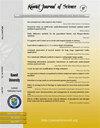锌硒纳米复合材料对无花果真菌病害的防治作用
IF 1.1
4区 综合性期刊
Q3 MULTIDISCIPLINARY SCIENCES
引用次数: 0
摘要
无花果对多种真菌感染都很敏感,影响着无花果的产量和品质。无花果锈病是无花果最常见的真菌病害之一,由无花果Cerotelium fici真菌引起。无花果锈病侵袭树叶,占作物感染的100%。此外,没有长期的策略来管理无花果锈病。近年来,纳米技术已经成为农业中的一种新选择,被证明对真菌感染更有效。该研究的主要目的是评估ZnSe纳米复合材料对真菌疾病的抑制作用。本研究以苦楝叶提取物为原料制备了纳米复合材料。紫外测试验证了ZnSe纳米复合材料的制备,发现在394 nm处有一个峰,预测带隙能量为3.15 eV。x射线衍射(XRD)结果表明该晶体为立方晶体结构,晶粒尺寸为28.82 nm。能量色散x射线(EDX)图显示,锌、硒、氧和碳是ZnSe纳米复合材料的主要成分。扫描电镜(SEM)显示,ZnSe纳米复合颗粒形状不规则,分布均匀,粒径在20 ~ 30 nm之间。傅里叶变换红外(FTIR)结果显示出强峰,表明存在许多官能团。调查发现,真菌病为无花果锈病,是由真菌病原菌无花果Cerotelium fici引起的。ZnSe纳米复合材料的独特用途有效地防止了无花果锈病,同时促进了发育,最大有效浓度为150 ppm。该剂量对感染前组无花果锈病的生长抑制率为97.93%,而在感染后组,150ppm的严重程度降低了95.36%。该研究结果表明,ZnSe纳米复合材料作为无花果锈病管理和作物品质改善的长期替代解决方案是有效的。本文章由计算机程序翻译,如有差异,请以英文原文为准。
Enhancing the control of fungal diseases in Ficus carica L. using Zn–Se nanocomposites
Ficus carica is sensitive to a variety of fungal infections, which have an influence on fig yield and quality. Fig rust, caused by the fungus Cerotelium fici, is one of the most frequent fungal diseases affecting fig plants. Fig rust attacks the leaves and accounts for 100 % of crop infections. Furthermore, there are no long-term strategies for managing fig rust. In recent years, nanotechnology has emerged as a novel option in agriculture, proving to be more effective against fungal infections. The primary goal of the study was to assess the efficiency of ZnSe nanocomposite in suppressing fungal illness that attacked F. carica. In this work, ZnSe nanocomposites were made using Melia azedarach leaf extract. UV examination validated the production of ZnSe nanocomposite, revealing a peak at 394 nm and a predicted band gap energy of 3.15 eV. X-ray Diffraction (XRD) measurements indicated a cubic crystal structure with crystallites measuring 28.82 nm. The energy dispersive X-ray (EDX) pattern revealed that zinc, selenium, oxygen, and carbon are the primary components of the ZnSe nanocomposite. Scanning Electron Microscopy (SEM) exhibited irregular forms with a homogeneous distribution of ZnSe nanocomposite particles ranging in size from 20 to 30 nm. The Fourier Transform Infrared (FTIR) findings revealed strong peaks, indicating the presence of many functional groups. The investigation discovered that the fungal illness was fig rust, which is caused by the fungal pathogen Cerotelium fici. The unique use of ZnSe nanocomposite efficiently prevented fig rust while simultaneously boosting development, with a maximum effective concentration of 150 ppm. This dose suppressed the growth of fig rust by 97.93 % in the pre-infection group, while in the post-infection group, 150 ppm decreased the severity by 95.36 %. The study's findings indicate the effectiveness of ZnSe nanocomposite as a long-term and alternative solution to fig rust management and crop quality improvement.
求助全文
通过发布文献求助,成功后即可免费获取论文全文。
去求助
来源期刊

Kuwait Journal of Science
MULTIDISCIPLINARY SCIENCES-
CiteScore
1.60
自引率
28.60%
发文量
132
期刊介绍:
Kuwait Journal of Science (KJS) is indexed and abstracted by major publishing houses such as Chemical Abstract, Science Citation Index, Current contents, Mathematics Abstract, Micribiological Abstracts etc. KJS publishes peer-review articles in various fields of Science including Mathematics, Computer Science, Physics, Statistics, Biology, Chemistry and Earth & Environmental Sciences. In addition, it also aims to bring the results of scientific research carried out under a variety of intellectual traditions and organizations to the attention of specialized scholarly readership. As such, the publisher expects the submission of original manuscripts which contain analysis and solutions about important theoretical, empirical and normative issues.
 求助内容:
求助内容: 应助结果提醒方式:
应助结果提醒方式:


